
Horse Shoeing – How much length?
What is the ideal length of a horseshoe by Yogi Sharp - the Equine documentalist

There is a long list of factors that influence the amount of length a farrier shoes a horse with, many are environmental; type of work, type of turnout and shoeing cycle, to mention a few. Even without these variables the ideal amount of length of shoe remains highly subjective. Research into the different biomechanical effects of different lengths needs to be done to work toward a standardisation of the industry, however we can use some physical principles to help establish some ideals to work towards, understanding that these may still have to be compromised according to the environmental factors. The hoof is a structure that responds to the biomechanical forces that act upon it following the laws of physics, therefore we can use maths and physical laws to help establish the ideals in shoeing that structure. When applying a shoe we are looking to create centralised load and biomechanical efficiency to preserve all biological structures, so shoeing around the centre of rotation (COR), in the authors opinion, has got to be the first step in establishing the ideal length of shoe. We also have to appreciate that the front and hind hoof have different conformations and should be assessed differently for their appropriate shoe lengths.
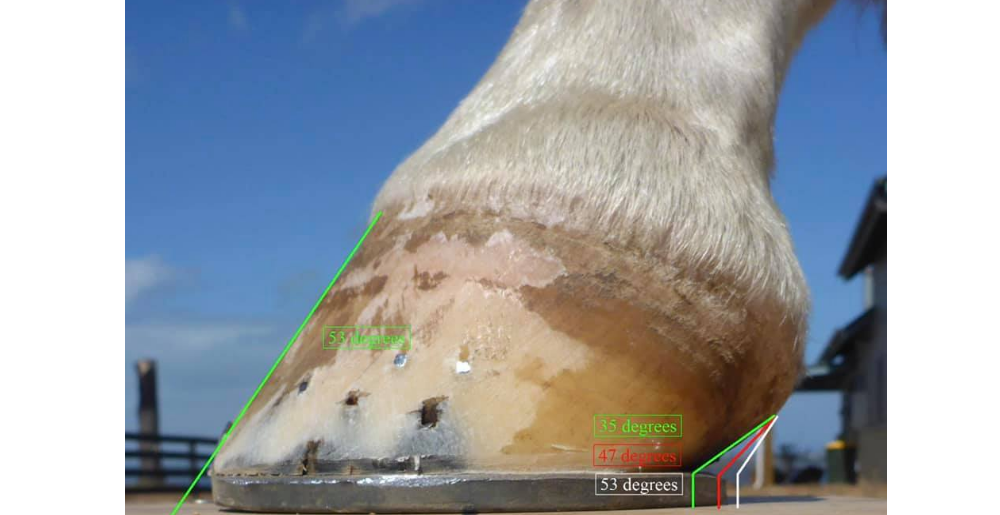
This picture from Progressive equine ( https://www.facebook.com/hoofscanandhoofcarecentre/ ) raised this question online, suggesting that establishing heel length to correspond with the dorsal wall angle is possibly a viable protocol. The author suggests this is a method that deserves investigation.
The following principles are the authors protocols for establishing length, as stated previously the industry requires evidence-based research to validate shoeing length.
Shoeing around the COR goes some way to establishing the authors chosen shoe length.

Foot mapping helps to establish the COR with the absence of radiographs.

Trimming to the highest widest part of the frog helps to point at the appropriate length of shoe. This point is expressed by O’Grady (2019) as the point at which to ideally trim and could be our first potential for shoe length fit, a common protocol for many farriers would then be to shoe to the widest part of the frog, being slightly further back, so this is our second potential shoe length. The length can be worked out as a 50/50 split around the COR instead of to an external anatomical point, although some would argue that 50/50 is not practical in some circumstances it does remain, in the authors opinion, an ideal and is often achievable by shoe fit.

This image shows a Mustad Equilibrium fitted under a long toe and with adequate length to create 50/50 around COR. The toe can be blunted without having the integrity stripped from it by excessive dorsal wall rasping.
The length of shoe here helps to establish the balance around the centre of rotation. Shoes like the Mustad Equilibrium can enable easier fitting around COR. Had this foot been in a toe clip the toe lever arm would remain much larger than 50%, or 50/50 could still be achieved with even more shoe length at the heels, which would become impractical. Essentially, in this context, shoe length depends on toe length and toe length depends on the length of lever arm from the COR. The author most often choses to come under the toe and add length at the heels in appropriate proportions to establish the 50/50. For further reading on shoeing around the COR
Shoeing the Centre of Rotation in 3 dimensions | Mustad Hoofcare en
a video showing establishing shoe length around COR can be watched at this link.
https://www.facebook.com/MustadHoofcare/videos/249035306903048

Radiographic appearance of 50/50 split around the COR. The length of shoe (assuming appropriate toe length) establishes this dorso-palmer balance.
This is a fundamental basic of the authors establishment of shoe length but there are other factors and reinforcing principles. When establishing balance around the COR a centralised load and centre of pressure is established because both halves of the foot have the same surface area and therefore pressure.
We can then look at this from a lateral view.
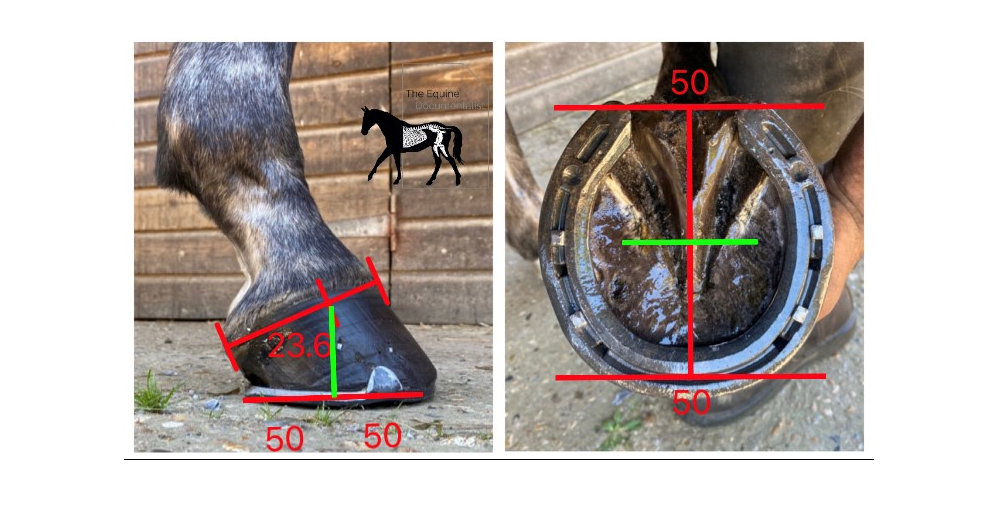
This image has been mapped using HoofmApp available from the Apple App store.
From a lateral view we can see where this length equates to in relation to the rest of the digit, the author would suggest that this is the basic minimum length of shoe fit (with environmental factors removed) with a foot with minimal distortion, one could argue this foot still looks like it could have more length, so how do we establish maximum length? When does length turn from support to leverage? Other factors begin to also come into play, what about when the bulbs are prolapsed? What about when the heels end forward of the highest widest part of the frog? Often these morphologies come hand in hand, we can use geometry to help re-establish reference points.
An important point to drive home is that trimming plays a huge role in creating optimal physical influences, the shoe should enhance this, trimming down the heels to the highest widest part of the foot is a good start. Often farriers are reluctant to lower heels too much, however often the heels that require lowering are of such a low angle that the gain in basal length far outweighs the drop in hoof angle, trigonometry can help to explain this.
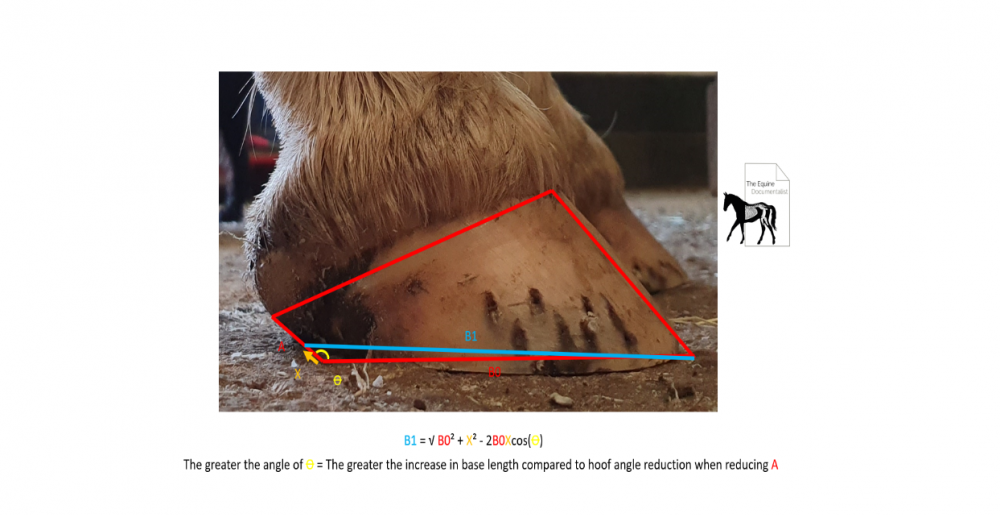
This image shows how underrun heels can be taken down with a smaller effect on hoof angle compared with more upright heels this is relevant because “length” of shoe applied depends on how close to the heel length required the heels already are with the trim. However, in the authors opinion, taking strong heels down to create closer to 50/50 solar proportions to the detriment of alignment is contraindicated and shoe fit is a more appropriate way of creating solar proportions.
In physics the triangle is the strongest shape and O’Grady (2013) expressed how the ideal conformation of the digit should present with a triangle, Balchin (2017) also discussed the applications of Pythagoras in assessing hoof conformation in his assessment of the golden ratios in the hoof.

Balchin (2017) right angle triangle created in 59% of feet, feet outside of this range were thought to have been pathological in some way. This finding could point at another suggestion for shoe length, the golden ratio, the length of the shoe is divided by 5 to have the same figure as the dorsal wall divided by 3 and the hairline divided by 4 and creating a right angle triangle with the dorsal wall and hairline. However this could still be questioned when we have pathological feet not following the golden rule.
We can continue the use of triangles to create further perhaps more practical possibilities for ideal shoe length.

A plum line taken from the centre of the distal condyle of the 3rd metatarsal, which often follows the middle of the leg mass close to the back of the bone, creates a right angle triangle with a straight hoof pastern axis, where this lands at the ground could be an indicator of appropriate shoe length. Radiograph courtesy of Progressive Equine.
The author uses this geometrical indicator and has found that anecdotally it commonly correlates to shoe placement around the COR, which also commonly correlates with the widest part and base of the frog. However, again this is not always practical especially if the horse has particularly sloping pasterns but could point toward a possible ideal.
With prolapsed heels/bulbs often this point can still appear too short, the heels will be run forward of the widest part of the frog often with parts of the bulbs almost becoming weight bearing in extreme cases, the author will then often use a line dropped from the back of the bulb as an appropriate shoe length. This correlates with O’Grady (2018) which discussed the appropriate length of hind shoe.

O’Grady (2018) discussed the appropriate length of hind shoe, the same vertical line dropped from the back of the metatarsal or centre of the distal condyle of the metatarsal, this usually also runs down the back of the bulb and should be where the heel of the shoe ends. This is a common authors reference point for the fitting of hind shoes. Hind feet often have a shorter distance from the COR to the base of frog/end of heel, in order to still maintain COR balance they may require more apparent length then fronts.

Fore limb plum line discussed applied to the hind shoe length. Note this may be more length after the heel than it would be in the fronts.
With Severely prolapsed hooves the heels are way forward of the base of the frog. Shoe length can be placed to the bulbs of the heel, with elevation, this helps to create the right-angle triangle. Here the shoe was almost 2 inches longer at each heel than previously fitted. Appropriate shoe length helps to create ideal geometrics. Often before elevation, using a line dropped from the condyle of the metatarsal can become inappropriate and impractical, especially in the font limb. Creating alignment also affects the length of shoe needed in two ways. Just to confuse things, more length is needed to allow for the elevation, however often creating better alignment reduces the toe lever arm making 50/50 around COR achievable, actually with less length. Often when dealing with next to no heel height, the bulbs almost become part of the bearing surface, This shoe fit went beyond 50/50 around the centre of rotation from external reference points, in order to account for the extremely low bulbs. In essence, choosing ideal shoe length comes from assessing the hoofs proportions and distortions, in order to help create geometric order and adequate support for that individual foot. Of course, once ideal length is noted, compromises often need to happen to account for the environmental and working factors. Note that trim, shoe length, shoe placement and elevation all work together to work towards establishing the ideal and therefore all have an influence on appropriate shoe length.
Posture also points toward appropriate shoe length and shoe length affects posture, recent research has shown that hind feet move backwards with more length (and sometimes elevation), however the shoe length markers usually correspond with fore mentioned parameters, if the rest of the conformation doesn’t look ideal then hoof geometrics need to be questioned, shoe length being one of them.

Appropriate length of shoe helps to create ideal posture/conformation. Hind feet are often shod too short allowing prolapse of unsupported heel bulbs. When you create the ideal many external markers correspond.
Another method suggested for optimum shoe length, as advocated by Mark Caldwell uses proportional lengths from certain reference points.
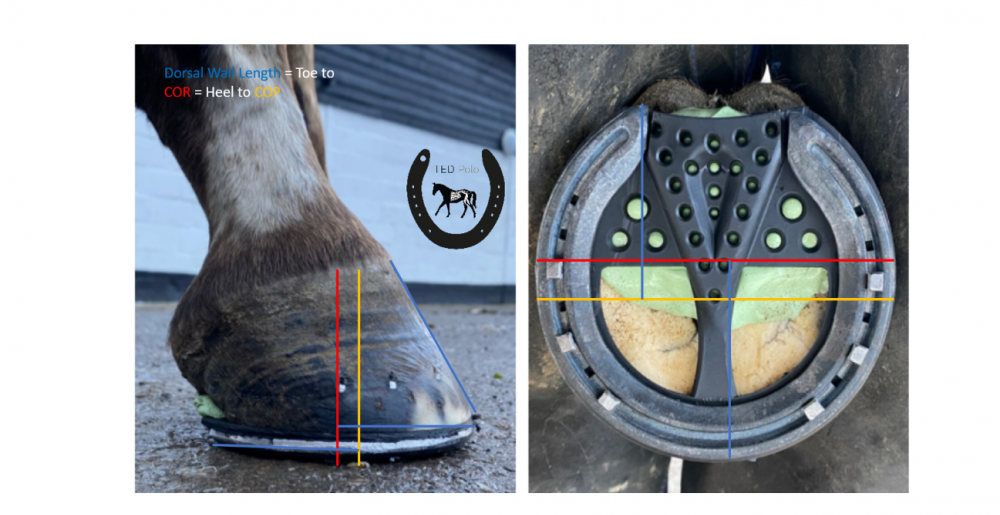
Caldwell suggests, following from Duckett (1990), that the dorsal wall length should correspond to the toe to the COR and Heel to COP and therefore is a measure of optimum shoe length.
This image is a good example of compromise that has to occur in real life situations. This is a polo pony that is playing at a very fast top level, however in the authors practice as much length and support is given in contrast to the often adopted practice of giving as little as possible to reduce shoe loss. In my experience, providing as close to ideal base proportions as possible within practical margins does not increase shoe loss, in fact the width and support means a more solid shoeing job through the shoeing cycle as the shoes don’t “slip” into the bearing border perimeter.
In conclusion appropriate shoe length remains highly subjective mainly due to environmental factors, the work being done by the horse and its management. However, when shoeing for the ideal and removing these factors, certain principles can help to establish correct shoe length, this ideal can then be worked backwards from when compromise needs to occur. Shoeing around the COR, or to create optimal proportions should be a base principle reinforced by other external reference points. Creating triangles and geometric proportions is proving to be sound practice in an emerging era of mathematical shoeing and these often correlate with anatomical reference points. Creating an optimal base of support is vitally important in supporting healthy hoof morphology and therefore appropriate shoe length remains an important subject for further research and daily practice. The author hypothesises that the widest part of the frog would be the minimum length of shoe appropriate outside of very short shoeing cycles, the maximum shoe length still remains elusive but the author proposes that lengths beyond the geometry created by the skeletal system i.e. the right angle triangle formed with the plum lines dropped from the metacarpal/tarsal could be the point at which support becomes leverage, or when the shoe extends beyond the extremities of the hoof in prolapsed heels, of course these all need quantifying by research. I leave you with a graphic showing the potential shoe lengths, including the dorsal wall angle suggestion by Progressive Equine, some will correspond with each other on some feet and others will not. This subject remains subjective, this article outlines the authors assessment of appropriate shoe length which is sometimes compromised due to the usual factors.
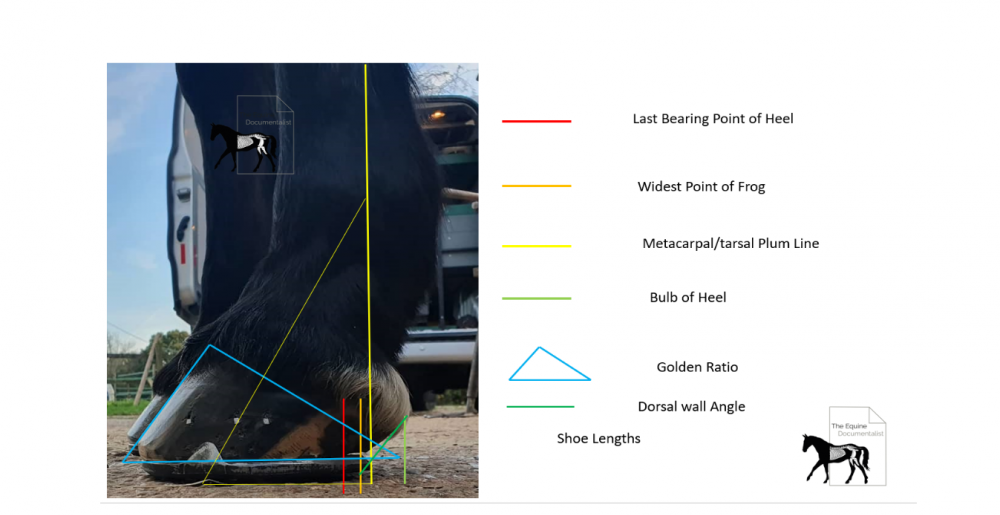
References
Balchin, 2017, https://www.wcf.org.uk/viewthesis.php?tid=12cac84659fb5f982db319254d283d73e4e8c40537d10dba334229fb45fbed8c
O’Grady, 2018, http://www.equipodiatry.com/How_to_Apply_the_Appropriate_Farriery_Principles.html
O’Grady, 2013 https://www.equipodiatry.com/HowtoEvaluatetheEquineHoofCapsule.html
O’Grady, 2019 http://www.equipodiatry.com/article_proper_physiological_horseshoeing.htm
Caldwell, 2019, Personal Correspondance